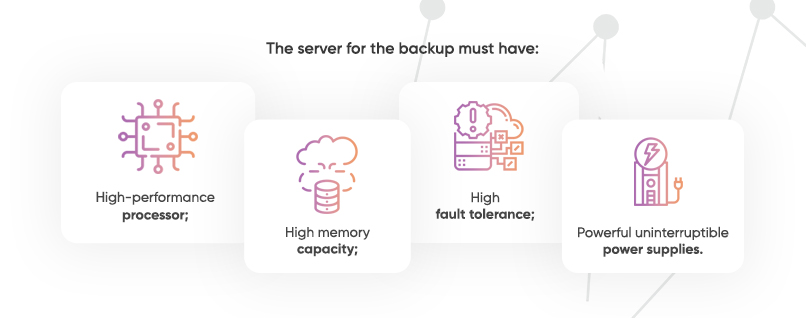Regular backups, which reduce the risk of losing critical information, are performed on special hardware. The data backup server has hardware and software settings to copy and restore data and DBMS.
The main purpose of a backup is to return the data to the state it was in at the time of recording (the duration of the process is directly related to the backup depth). Creating and restoring a backup copy is time consuming, but it guarantees data safety. For maximum reliability, it is recommended to create several backups to different disks, as well as to the cloud.
All backup programs and servers are fully protected from external influences. To this end, equipment is placed in network segments and traffic is filtered through gateways. If separate segments cannot be created, communication is arranged via secure channels (SSL/TLS). A popular solution is the cloud, which has protection against DDoS attacks and a firewall.
The server for the backup must have:
- High-performance processor;
- High memory capacity;
- High fault tolerance;
- Powerful uninterruptible power supplies.

Data backup solutions
To select and deploy a file server one often chooses a ready-made solution that does not require administration and multi-level configuration. The storage system can be deployed both in a local network and in a data center.
The amount of space for backups should take into account the annual growth of information, not only that required at the moment. The server can be both physical equipment and a virtual machine simulating an operating system outside the IT infrastructure.
As a result of deploying a remote server for a backup, the client receives:
- good and profitable protection;
- fast recovery;
- significant technical capabilities, including in the absence of the required IT infrastructure in the company.
Data Storage Systems:
- solve the problem of growing volumes of information;
- save space with compression and deduplication functions.
There are file-based, block-based and object-based storage systems. They differ in data storage format, access methods, ease of management and performance. When selecting a data storage system, they take into account:
- dependence of access speed on the type of data;
- volumes of supported disk drives;
- fault tolerance level;
- performance levels;
- vendor preferences.
Object storages are high-level, designed to handle large chunks of data distributed across containers. They store gigabytes as well as petabytes of information without being tied to specific machines.
Data backup to your infrastructure
Write us a message to get additional information.
or book a free consultation
If you rent a backup server, you don’t have to worry about the reliability of data storage and have a guarantee of fast and complete data recovery. Data is protected from viruses, data access is only on the client side, and backup space is easily scalable.